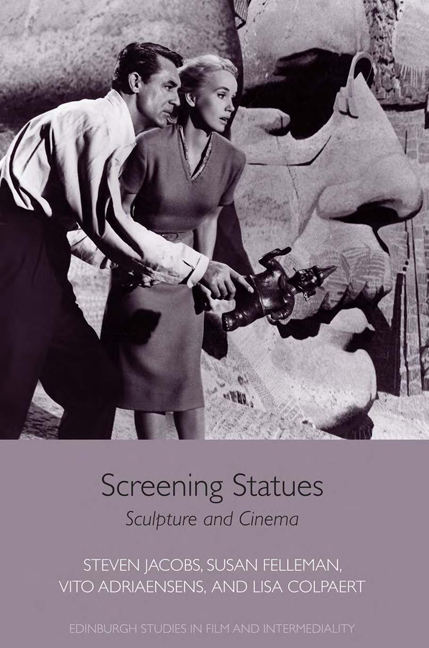Book contents
- Frontmatter
- Contents
- List of Figures
- Acknowledgements
- Introduction: The Marble Camera
- PART I
- 1 The Sculptor's Dream: Living Statues in Early Cinema
- 2 The Mystery … The Blood … The Age of Gold: Sculpture in Surrealist and Surreal Cinema
- 3 Carving Cameras on Thorvaldsen and Rodin: Mid-Twentieth- Century Documentaries on Sculpture
- 4 Anatomy of an Ovidian Cinema: Mysteries of the Wax Museum
- 5 The Night of the Human Body: Statues and Fantasy in Postwar American Cinema
- 6 From Pompeii to Marienbad: Classical Sculptures in Postwar European Modernist Cinema
- 7 Of Swords, Sandals, and Statues: The Myth of the Living Statue
- 8 Coda: Returning the Favor (A Short History of Film Becoming Sculpture)
- PART II
- Bibliography
- About the Authors
- Index
2 - The Mystery … The Blood … The Age of Gold: Sculpture in Surrealist and Surreal Cinema
from PART I
Published online by Cambridge University Press: 23 June 2018
- Frontmatter
- Contents
- List of Figures
- Acknowledgements
- Introduction: The Marble Camera
- PART I
- 1 The Sculptor's Dream: Living Statues in Early Cinema
- 2 The Mystery … The Blood … The Age of Gold: Sculpture in Surrealist and Surreal Cinema
- 3 Carving Cameras on Thorvaldsen and Rodin: Mid-Twentieth- Century Documentaries on Sculpture
- 4 Anatomy of an Ovidian Cinema: Mysteries of the Wax Museum
- 5 The Night of the Human Body: Statues and Fantasy in Postwar American Cinema
- 6 From Pompeii to Marienbad: Classical Sculptures in Postwar European Modernist Cinema
- 7 Of Swords, Sandals, and Statues: The Myth of the Living Statue
- 8 Coda: Returning the Favor (A Short History of Film Becoming Sculpture)
- PART II
- Bibliography
- About the Authors
- Index
Summary
Figurative sculpture had a special status within the visual universe of Surrealism. Iconographically, statues are a prominent element in the dream¬like spaces of Giorgio de Chirico's paintings of 1913–14 that so enchanted André Breton and friends after the end of the war and became among the first and most paradigmatic images associated with the movement. Statues appear in many other Surrealist paintings, including those of Salvador Dalí, where, although they might stand on plinths or pedestals, they equivocate between the appearance of inanimate and living bodies, through the impres¬sion of liquidity and putrefaction that infects all his visions. In Surrealist collages, too, bodies are often rendered equivocally sculptural through fragmentation, for instance in photographic or printed images of the female nude rendered headless or otherwise dismembered to resemble antiques, in the works of Max Ernst and others. René Magritte, Paul Delvaux, Man Ray, Pierre Boucher, Picasso, and Jean Cocteau, among others associated with Surrealism, also incorporated statuary into their paintings, drawings, and photographs.
In the period of the second manifesto – 1929 and after, when Surrealist filmmaking intensified – two trends emerged as especially salient: the object, with its inherently sculptural presence, and photography. The Surrealist object was a distinct category of Surrealist visual culture and a special sort of artifact – something found, modified, or assembled – whose significance derived from the concept of objective chance. Some objects incorpo¬rated or altered sculptural prototypes (Man Ray's 1936 Venus Restaurée, for instance). Such quasi-sculptural entities as mannequins (showcased in the 1938 Exposition Internationale du Surréalisme at the Gallerie des Beaux- Arts in Paris) and dolls (especially Hans Bellmer's Puppe) were favorite photographic subjects.
The same sort of public statuary that had resonated in the paintings of de Chirico also occupied the marvelous, uncanny Paris in pictures by Atget and other photographers associated with the movement, including Joseph Breitenbach, André Kertész, Jacques-André Boiffard, and Brassaï. Gradiva, a Surrealist gallery opened on the Left Bank in 1937, was named for an Antique bas-relief at the center of a novella that was the subject of a Sigmund Freud essay.
- Type
- Chapter
- Information
- Screening StatuesSculpture and Cinema, pp. 46 - 64Publisher: Edinburgh University PressPrint publication year: 2017

